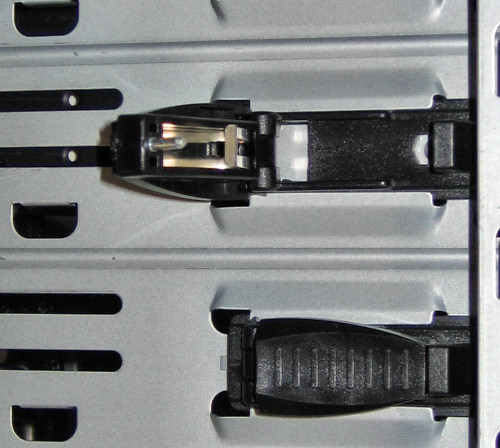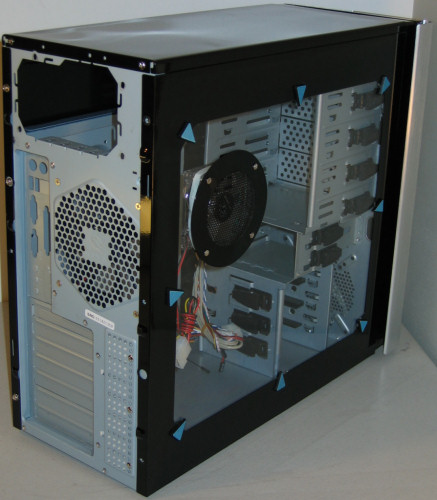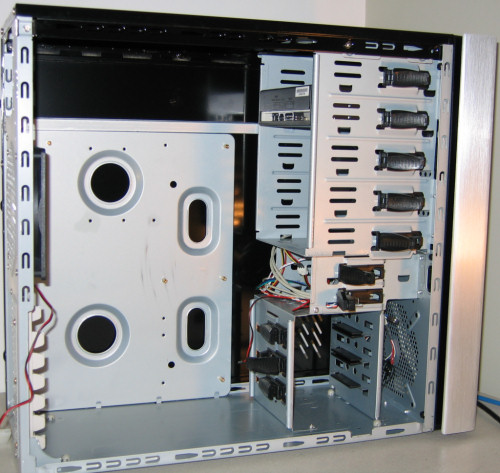Price-Point Comparing Three-Way Case Shootout
by Joshua Buss on January 13, 2006 12:05 AM EST- Posted in
- Cases/Cooling/PSUs
Raidmax X1 (cont’d)
Turning the case more, we can see the relationship of the three main elements of the active cooling in the X1: the rear 120mm, the side-mounted 80mm, and the potential power supply fan(s).
Like the P150, the X1 too has additional passive vents near the expansion slots. It’s also easier to tell now that at least in terms of 3½” drive bays, the X1 and P150 also basically tied, as they can both house 1 external and 4 internal drives. The X1’s drive bays are all tool-less, and we’ll explain the usage of the black units visible in the previous two pictures shortly. Before opening up the case though, let’s turn the case around and have a look at the bottom as well.
While certainly not as nicely-finished as the underside of the P150, the X1 still does have feet, but they’re not going to do anything for the absorption of vibrations. More intake ventilation can be found here under the front bezel, and there is a space for an additional 80mm to be mounted in order to actively bring in cool air right onto the hard drives visible here on the right side panel.
Taking off the left side and peering into the chassis reveals a spacious interior delightfully void of any additional crossbars that could make installation difficult. Granted, bars like this are actually preferred by people more concerned with case stability and longevity, but in testing and handling, we still didn't get the impression that the X1 felt wobbly or weak by any means. One very minor strike against the X1, though, is that it doesn't support quite as many form factors as the P150, as one can tell by looking at the available holes for motherboard stand-offs, but the standard ATX sizes won't be any problem.
Notice again how every bay incorporates the usage of tool-less locks. While it might be pretty obvious from the picture, it is still worthy of mention that the locks are all the same and are also equally simple to use. They simply push in and slide to both lock and unlock. In the following close-up, the pin that actually holds the drive into place is pretty visible, and in testing, these did a good job of holding the drives very securely.
Turning the case more, we can see the relationship of the three main elements of the active cooling in the X1: the rear 120mm, the side-mounted 80mm, and the potential power supply fan(s).
Like the P150, the X1 too has additional passive vents near the expansion slots. It’s also easier to tell now that at least in terms of 3½” drive bays, the X1 and P150 also basically tied, as they can both house 1 external and 4 internal drives. The X1’s drive bays are all tool-less, and we’ll explain the usage of the black units visible in the previous two pictures shortly. Before opening up the case though, let’s turn the case around and have a look at the bottom as well.
While certainly not as nicely-finished as the underside of the P150, the X1 still does have feet, but they’re not going to do anything for the absorption of vibrations. More intake ventilation can be found here under the front bezel, and there is a space for an additional 80mm to be mounted in order to actively bring in cool air right onto the hard drives visible here on the right side panel.
Taking off the left side and peering into the chassis reveals a spacious interior delightfully void of any additional crossbars that could make installation difficult. Granted, bars like this are actually preferred by people more concerned with case stability and longevity, but in testing and handling, we still didn't get the impression that the X1 felt wobbly or weak by any means. One very minor strike against the X1, though, is that it doesn't support quite as many form factors as the P150, as one can tell by looking at the available holes for motherboard stand-offs, but the standard ATX sizes won't be any problem.
Notice again how every bay incorporates the usage of tool-less locks. While it might be pretty obvious from the picture, it is still worthy of mention that the locks are all the same and are also equally simple to use. They simply push in and slide to both lock and unlock. In the following close-up, the pin that actually holds the drive into place is pretty visible, and in testing, these did a good job of holding the drives very securely.















69 Comments
View All Comments
bobbyto34 - Tuesday, January 17, 2006 - link
Silentpcreview is the first website that posted a review on the P150 (nearly 2 months ago). They got it long before the case was available in stores. Perhaps is it also because the guy from spreview worked with antec on the p180 (that's what they said in their P180 review).Sure we can criticize this test of the PC 150 because they use stock cooler. But if it says that the antec tricool is cleary audible at minimum speed and that a 150$ case makes as much noise as a 40$ case + silent PSU...
I prefer to know the product that i'm buying, specially if it costs 150$....
GameManK - Sunday, January 15, 2006 - link
...I still think it's a little ridiculous to compare noise measurements when using a stock cooling 6600gt and a Thermaltake CPU cooler... and is there a fan on that DFI too?? yuck. And of course the PSU.. no offense to AT, but I'd like to see a silentpcreview.com review of it.This review didn't use the hard drive suspension in the P150, and though I did suspend my drives in my Sonata, I don't really know how much of a difference it actually makes (my maxtor hdd is also quiet, and i never tried hardmounting the wd); there is no way that this review could have shown the benefits of using the suspension, or even the silicon grommets, in the P150 over the hard mounting in the other cases because the test system used components that are significantly louder than (decent) hard drives.
JoshuaBuss - Monday, January 16, 2006 - link
Our stock 6600 GT cooler, thermaltake cpu cooler, and PSU were all hand picked for being exceptionally quiet... the grommets did an exceptional job of isolating the hard drives - perhaps seeking noises would've been a few fractions of a decibel less in the fully suspended mode, but it simply wasn't the issue when it came to the noise emanating from the P150.. the tri-speed fan was a great deal louder than our hard drive.BPB - Friday, January 13, 2006 - link
The Antec is $113.99 before shipping at http://www.newegg.com/Product/Product.asp?Item=N82...">Newegg right now. That's with the power supply. That seems pretty reasonable to me. Problem is, I don't need a power supply. I have the 450W already. Sell the power supply on eBay and the price could end up being around $50. I said could end up.BPB - Friday, January 13, 2006 - link
Oops! Forgot to mention that the $113.99 is after rebate. So it's $157.98 with shipping, $132.98 after rebate.Jynx980 - Friday, January 13, 2006 - link
Some of these comments are pretty harsh. Its a mini review comparing various price points and people seem to be expecting a lot more. Eleven pages for three cases seems more than adequate. One suggestion I have would be to make your user name the author name the same for the comments. The name 'Tamale' doesn't seem to have anything to do with the article and I only noticed it from the email association.Tamale - Friday, January 13, 2006 - link
I'm still working with the site administration team to get "Joshua Buss" as a registered login name.mindless1 - Friday, January 13, 2006 - link
Forgive me if I've overlooked it, but in the noise comparisons the Antec and Raidmax are comparable, BUT does the Raidmax have a comparable filtration system?That is a huge issue, as one who has used filters for years I can assure you that any filter remotely fine enough to be effective has a significant impedance to airflow and to have one case filtered better (or at all) that still achieves same noise levels is no small feat.
However, it's flawed. One can't design a case such that there's only passive intake and throw a filter on the front else it causes more air intake through the drives and port holes, accelerated dust accumulation in them and all the other seemingly minor gaps. Therefore, it's necessary to install the two front 92mm pusher fans and have them at high enough flow rate that the case has positive pressurization so filtered air is exahaust out the drives and gaps rather than sucked in. Those front fans will also signficantlly increase noise levels perceptible to the user, unfortunately, thuogh a bit of dense foam bonded to the front bezel (interior wall) will help.
It's not quite clear what kind of lighting was used to take the pictures, but it is disappointing that the two shades of white (plastic and paint) on the Antec didn't match up. IMO, two different shades of the same color (when off as much as in the picture) is even worse looking than if they had aimed for an entirely different color. Personally I hate glossy paint too, it never holds up as well and gets fingerprints on it.
overall, despite these things the Antec looks like a winner to me. In fact if I didn't know better I'd think they lifted a few ideas from various case mods I've posted over the years. Either way, I thought they were good ideas, they proved to be too, and I'd certainly want them on a case I bought instead of having to DIY.
Tamale - Friday, January 13, 2006 - link
Good observations... the lighting we use is chosen carefully so that it can bring out differences in materials somewhat moreso than normal.. that being said, the difference you're noticing in these pictures has been exaggerated and wouldn't be as noticable under normal lighting conditions. There still is a difference though, which is understandable since one surface is metal and the other is plastic, but I doubt you'll find the case unattractive. The finishes are very nice.bob4432 - Friday, January 13, 2006 - link
a maddog psu? that is the best you as a reviewer have laying around? give me a break, at least throw in a old antec one or something, maddog - isn't that compusa generic stuff?